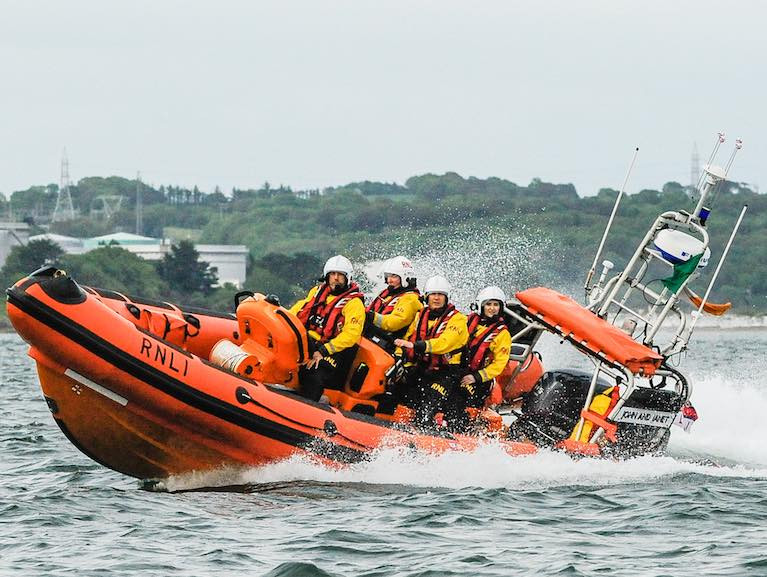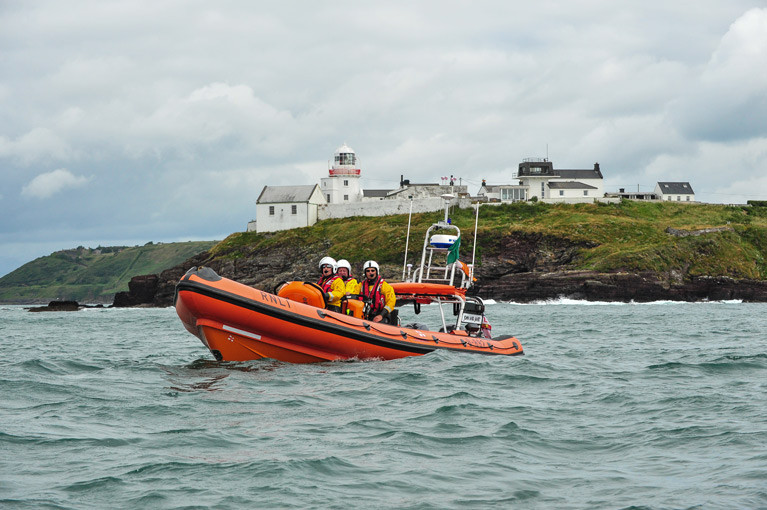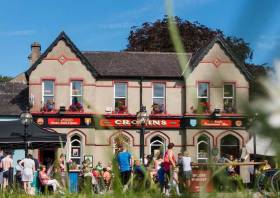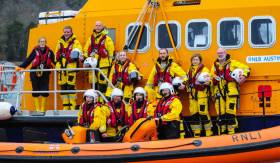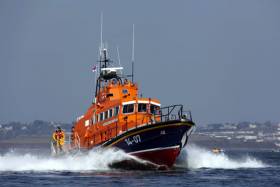Displaying items by tag: Crosshaven
Crosshaven RNLI lifeboat was paged at 2.10 am and launched at 2.30 am this morning to a vessel broken down between Myrtleville and Fountainstown off Cork Harbour.
Initially, the position was given as 2 miles East of Myrtleville. The volunteer crew had a casualty mobile number and were able to get a Lat/Long position from their phone which placed them between Myrtleville and Fountainstown.
The RIB, with two persons on board had run out of fuel, had no working navigation lights and no working VHF radio. One of the casualties was very cold and the two casualties were transferred to the lifeboat before taking the RIB in tow to Crosshaven.
The lifeboat was recovered, refuelled, washed down and declared ready for service once more at 4.50 am.
The crew on this service, Alan Venner in command with Claire Morgan, Peter Lane and Jonny Bermingham.
Shore Crew, Norman Jackson, Jenna O’Shea, Richie Leonard, James Fegan, Gary Heslin and Kevin McCarthy.
Helm, Alan Venner commented on the importance of ''having your vessel in good order and making sure you have enough fuel onboard before heading to sea."
A family of six had a close call when one of their Kayaks capsized in Cork Harbour.
The double kayak capsized after being hit by the wake of a passing vessel throwing the father and his 4-year-old son into the water.
Crosshaven RNLI volunteers immediately launched after being paged at 12.40 pm this afternoon and found the family ashore on Spike Island. The child was very cold after spending 20 to 30 minutes in the water and initially, the crew were very concerned for his welfare. The crew warmed the child up in what was warm sunshine and continued to monitor him. Eventually, the Child was eating and drinking with no signs of distress and it was decided to transport the family and their kayaks back to their vehicle at Paddy’s Point slipway.
Crew on this service was David Venner in command with Norman Jackson, Derek Moynan and Alan Venner. The launch and recovery crew were JP English (DLA) , Michael McCann and Jon Meaney.
Crosshaven RNLI Lifeboat Assist Anglers off Cork Harbour
Crosshaven RNLI Lifeboat crew in Cork Harbour went to the assistance of two anglers today (Saturday, 6 February) after their vessel had mechanical problems, one and a half miles South East of Roches Point.
The volunteer lifeboat crew were paged at 9.42 am this morning and made their way to the 32' angling vessel in reasonably calm seas, before attaching a tow line for the four-mile journey back to Crosshaven. The vessel was made secure at Salve Marine pontoons before the crew returned to station at 11.35 am.
The crew on this shout were Ian Venner in command with Molly Murphy, Peter Lane and Richie Leonard. Commenting after the event, Helm Ian Venner said, ‘The casualty crew
did exactly as they were meant to, and called the Coast Guard as soon as they had a problem.. The engine problems meant they were dead in the water and at the mercy
of the tides. Fortunately, there was only a 10 to 12 Knot Northerly wind blowing them away from the land.’
The lifeboat was recovered, washed down, refuelled and declared ready for service once more at 12.15 pm
Crosshaven RNLI Assist Powerboat with Two Persons Onboard
The volunteers of Crosshaven RNLI lifeboat were paged at 5.51 pm this evening (Saturday 19 July) to go to the aid of a broken-down vessel, East of Power Head at the entrance to Cork Harbour.
The lifeboat with Ian Venner in command and with Claire Morgan, Derek Moynan and Jonathan Birmingham on board made best speed towards the Casualty in good conditions and a slight sea.
First reports were that the 23' powerboat with two persons on board had broken down and was at anchor awaiting help.
Enroute, the lifeboat crew was informed by the Coast Guard that the casualty had managed to restart their engine and was slowly making for Ballycotton and would be obliged for the lifeboat to escort the vessel into the harbour.
The lifeboat crew were happy to oblige and saw the vessel safely moored in the harbour at Ballycotton.
Commenting on the incident, helm, Ian Venner said the vessels owner had 'done everything by the book and called the problem into the Coast Guard immediately and then anchored the vessel.'
Launch crew on this call out were Sandra Farrell, Susanne Deane, Richie Leonard and Caomhe Foster. The lifeboat returned to station at 8 pm.
Hope For Royal Couple To Mark Cork Club’s Tricentenary On Proposed Visit
Royal-watchers will be hoping the Duke and Duchess of Cambridge pay a visit to the Royal Cork Yacht Club during its 300th anniversary celebrations when the royal couple come to Ireland within the next three months.
As EchoLive.ie reports, William and Kate are expected to visit Cork, Dublin and none other location as part of a two-day visit, discussions for which are in their early stages.
The Royal Cork’s home base of Crosshaven on Cork Harbour is no stranger to royal visits, as the village last summer hosted a whistle-stop engagement for the Dutch royal family.
Cronin’s Of Crosshaven In The Running For World’s Best Sailor’s Bar
Cronin’s Pub in Crosshaven has made the shortlist for the 11th Annual Wight Vodka Best Sailor’s Bar award.
Hosted by Eurosail News and supported by Seahorse magazine and Latitude Kinsale, the competition is a chance for sailors to share their best stories and drinks recipes from bars around the globe.
And this year Cronin’s in Cork Harbour joins an illustrious list that includes a number of idyllic drinking holes from Hong Kong to Bermuda.
The winner gets their name in history, a bottle of Wight Vodka, a plaque for the bar wall, and a beautiful work of map art from Latitude Kinsale.
Voting begins today, Monday 16 December, and ends on 14 January — with the winner announced on Thursday 16 January.
Cork Lifeboat Crews To Share Their Lifesaving Stories This Wednesday On RTÉ’s Nationwide
Volunteer lifeboat crews from Crosshaven and Ballycotton RNLI in Cork will share their own stories of how they got involved with the lifesaving charity on TV for RTÉ One’s Nationwide this coming Wednesday 18 December.
And the two stations will also carry out a joint exercise to recover an unconscious casualty from the water, as they appeal to the public to support the RNLI’s ‘Perfect Storm’ fundraising campaign.
In Crosshaven, local business owners Aoife Dinan, of Rejuvenate beauty salon, and Denis Cronin of the popular Cronin’s Bar both volunteer for the Cork Harbour village’s lifeboat crew.
Denis was a keen surfer before he volunteered for the lifeboat and now answers the pager by jumping on his pushbike and heading to the station a couple of minutes away.
Aoife and her partner lost a close friend to drowning and she is now an active member of the lifeboat crew, often running from her business to make callouts at the station.
Best friends Molly Murphy and Caoimhe Foster joined the lifeboat together when they were in fifth year in school. They speak about what it was like to rush out of the classroom and down to the lifeboat station for a callout and to leave their schoolmates behind.
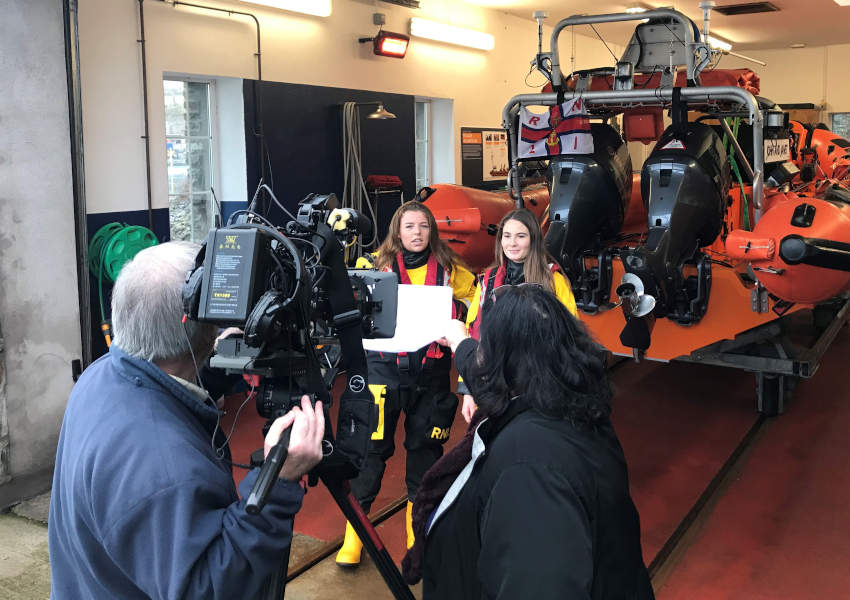 Crosshaven RNLI volunteers and best friends Molly and Caoimhe face the RTÉ Nationwide camera | Photo: RNLI/Niamh Stephenson
Crosshaven RNLI volunteers and best friends Molly and Caoimhe face the RTÉ Nationwide camera | Photo: RNLI/Niamh Stephenson
Ballycotton RNLI crew member Alan Cott lost his brother Glynn when the Maggie B sank in 2006. He is very proud of his involvement with the lifeboat and is honouring the memory of his brother in the work he does to save lives at sea.
Speaking about the programme and the launch of the Perfect Storm appeal by the RNLI, area lifesaving manager Brian O’Driscoll said: “Our lifeboat crew are what is best in the RNLI. These men and women give up their time to train and launch lifeboats in all weathers and to all types of situations.
“Our thanks to the Nationwide team for visiting two of our Cork lifeboat stations and speaking to our volunteer lifeboat crew about why they do it and what they get out of it.
“Many people don’t realise that the RNLI is a charity and we depend on the generosity of the public to continue with our work saving lives at sea.
“Aoife, Denis, Alan, Molly and Caoimhe give their time and their passion to the RNLI and in return they get the training, skills and equipment to be able to help those in trouble at sea. We are very grateful for the support of the public and we don’t take it for granted.”
To support the RNLI’s Perfect Storm appeal this Christmas, helping to ensure the charity’s brave volunteers can continue saving lives at sea, visit RNLI.org/ThePerfectStorm
Courtmacsherry RNLI was among the search and rescue agencies who responded yesterday morning (Thursday 8 August) to reports that a man had taken ill during a diving expedition to the wreck of the Lusitania.
As reported by The Irish Times, it is suspected that the diver, one of a group of eight, developed the bends as he returned to the surface from the wreck site some 18km off the Old Head of Kinsale.
The Naval Service vessel LÉ George Bernard Shaw diverted from patrol in the area and sent a team to bring the casualty on board, from where he was airlifted to hospital.
Later the casualty was transferred from Cork University Hospital to University Hospital Galway, which has a decompression unit.
As the emergency operation wound down, Courtmacsherry RNLI’s all-weather Trent class lifeboat Frederick Stormy Cockburn received another Mayday call, to a 30ft yacht in difficulty off the Seven Heads coast.
The lifeboat was at the scene within 20 minutes and proceeded to tow the stricken vessel back to the safe surrounds of Courtmacsherry Pier.
Commenting on the morning’s callouts, Courtmacsherry lifeboat operations manager Brian O'Dwyer praised all the crew for their professionalism and fast response.
Elsewhere, shortly after 1pm, Crosshaven lifeboat volunteers were called to a medical evaluation from Spike Island in Cork Harbour.
According to Crosshaven RNLI, crew member Aoife Dinan performed casualty care until paramedics arrived, having been brought to the Island by the Port of Cork RIB.
The Irish Community Air Ambulance also landed on the island along with Crosshaven Coast Guard.
“Very sadly, the male casualty, who was a foreign visitor, was declared deceased,” said press officer Jon Mathers. “Our sympathies are with the family of the deceased man; may he rest in peace.”
Crosshaven Lifeboat Assists Yacht With ‘Smoke In Engine Bay’
Crosshaven RNLI has came to the aid of a sailor after his yacht got into difficulty off Cork Head on Friday (21 June).
The UK-registered yacht en route from Kinsale to Crosshaven broadcast a PAN PAN alert after its skipper spotted smoke in his engine bay.
Crosshaven’s crew of Warren Forbes, Denis Cronin, Aidan O’Connor and Derek Moynan were paged at 4.13pm and launched their inshore lifeboat to the reported position.
Once on scene, they assessed that there was no fire in the engine bay, but that the engine was disabled.
The casualty vessel was then towed to Crosshaven boatyard and safely berthed.
Crosshaven RNLI helm Warren Forbes said: “A fire onboard a vessel is a sailor's worst nightmare but fortunately no fire was observed when we arrived on scene.
“The yachtsman made the correct decision by not opening the engine bay and calling for help.”
More recently in Cork, Youghal RNLI launched in poor weather conditions yesterday (Sunday 23 June) to reports of a swimmer in trouble some 500m off Claycastle.
Fortunately the swimmer managed to get to safely back to shore as the inshore lifeboat arrived at the scene.
Crosshaven Lifeboat Assists Injured Fisherman Off Graball Bay
#Lifeboats - Crosshaven RNLI launched to the aid of an injured fisherman off Graball Bay yesterday morning (Thursday 14 March).
The volunteer crew of the Crosshaven inshore lifeboat, John and Janet, were paged at 10.27am to assist a 10m fishing vessel with an injured crewman onboard.
With Aidan O’Connor in command and Norman Jackson, Georgia Keating and Molly Murphy onboard, the lifeboat met with the incoming casualty boat off Graball Bay some 12 minutes later.
Two of the lifeboat crew transferred to the fishing boat to administer casualty care to the injured man, who was in severe pain from a suspected broken arm and a head injury.
As it was deemed too dangerous due to the sea state, and too painful for the casualty, to be transferred back to the lifeboat, the fishing vessel continued to Crosshaven under escort before the injured man was handed into the care of paramedics for transfer to hospital.
Speaking following the callout, Crosshaven RNLI deputy launching authority Hugh Mokler said: “The volunteer crew responded quickly and made the casualty, who was in a great deal of pain as comfortable as possible until they were able to hand over to the ambulance service. Today, their casualty care training made a difference.”
Elsewhere, the body of a West Cork fisherman was recovered from the shoreline at Killybegs, shortly after he was reported missing yesterday afternoon.
As BreakingNews.ie reports, the man in his 50s had been working on a Cork-based boat that was docked in the Donegal fishery harbour.



























